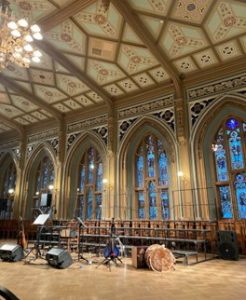by Eduardo Astudillo, University of Tartu
While discovering Riga, thanks to the opportunity given by the BAMSE intensive course on Resilience in Nordic-Baltic democracies, I, as a visitor, was able to see that some changes were happening.
One that caught my attention was the removal of instructions in the Russian language around the city. The two examples that made me realize this were the removal of Russian letters from the wall of the central station in Riga, and the removal of Russian language from the public transportation App.
All these changes are coming as a reaction to Russia’s invasion of Ukraine. Even though Latvia has always had in their medium-term plans “to ensure, maintain, and develop the Latvian language as the official state language and the common language in the society” (Letter of Latvian Government to the UN, 23/12/22).
Efforts like this one and others related to the de-Russification process, such as the dismantling of Soviet-era war monuments, the removal of some Russian diplomats, and the announcement of exclusively Latvian-speaking primary education by 2025, are being implemented firmly and immediately.
During our visit and academic schedule, as a guest group, we were also lucky enough to participate in an ‘NGO cafe’ experience to get to know the work and their vision for a better Latvia. Social workers, academics, youth organizations, and civil society engagement advocators, among others, were participating in this instance. These organizations all work with groups or individuals who need support in getting the same opportunities as everyone else and, with this, towards the nation’s interest of building a stronger Latvia. All the NGOs still had professionals ready to deal with the Russian-speaking population, and they were also convinced that this would continue. Two specific projects where this slow transition towards adopting the full Latvian language was happening were: (1) social workers aiming to integrate kids in contexts of social vulnerability and (2) efforts to create Russian-speaking media channels so that the Russian speaking population can have access to claims away from the Kremlin’s control.
The previously mentioned government-promoted initiatives, of either eliminating or maintaining foreign language considerations depending on the context, could find situations where contradictory viewpoints collide.
Latvia should continue rebuilding their national identity after all the damage done during the occupation period. At the same time, considering the current Russian invasive offensive, they should also require their local Russian-speaking residents to prove some of their patriotic credentials.
But Latvia should be careful at the level of reform and legislation implementation. Language policy fulfillment should be carried out considering all aspects of language learning and integration.
The support of mediators on some of the levels where these transformations take place could help make these transformations more sustainable in time.
The risk that the formation of closed-off parallel communities occurs, even if it means a very small percentage of Russian-speaking Latvians, is not worth it in cases where policy planning and legislative transitions can deal with more flexible deadlines.
- This blog is a part of a blog series written by the BAMSE Riga intensive course students. The blog series analyses the concept of resilience from five different viewpoints: democracy in crises, regional responses, social consequences, relevance of history politics and cultural approaches. This blog belongs to the cultural approaches to resilience part of the blog series. Read more about the blog series on Bamse News & Events website.




